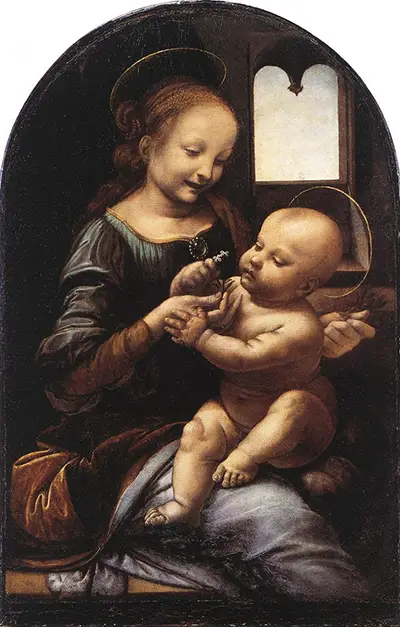It dates from the very first days of Leonardo’s career as an artist and portrays the Madonna and Child, a subject often revisited by Leonardo during his lifetime but particularly so during this early period.
It is in fact thought that this series of paintings was the first time that Leonardo had painted independently while still studying under and being under the influence of his master, Verrocchio, from whom he learnt his initial craft.
He went on to produce a series of additional sketches and many drawings on the same theme, several of which are seen to be preparation for this work, given the similarity in the way the figures are portrayed in relation to each other.
The painting is known as the Benois Madonna because it is named after the 19th century artist Leon Benois who sold it to the Hermitage in Leningrad, Russia in 1914. There is an element of mystery around this as it resurfaced suddenly after the artwork had disappeared and been unseen for centuries.
Leonardo's preferred method of approaching the Madonna and Child theme generally entails a study of the emotions that pass between the mother and child in what are seen to be private moments.
Leonardo aimed to make the mother and child subjects of his painting look natural. At the time, these paintings were noteworthy for their detail and the complexity, both of which were relatively unusual at the time.
The Madonna is wearing contemporary Renaissance-style clothing with an appropriate hairstyle for the age. She is portrayed with a flower which the Child is playing with and which is significant because of its similarity to the shape of the crucifix.
For its era the painting is noteworthy and unusual because it appears to depict a happy scene, evidenced by the joyful look on the young Madonna's face. See also Raphael's La Belle Jardiniere, Michelangelo's Manchester Madonna and Botticelli's Madonna and Child.
The artist deals almost playfully with his chosen subject. The young mother's love for her child can be clearly seen and there is an uncommonly natural technique in the painting. It was also unlike works of art painted by other artists of the era because of its use of light and shadow.
This painting is generally considered to be a genuine work by Leonardo da Vinci. However, the reaction of art critics has not always been flattering. Criticism has been aimed for example at the unhealthy and unattractive appearances of the subjects and the baby's hands.
A detail of the painting which casts doubt over its authenticity is the treatment of the ears which are considered by many not to be lifelike, a trait inconsistent with Leonardo’s great talent and skill when it came to painting anatomy.
Another criticism relates to the way the Child sits awkwardly in the lap of the Madonna, creating the unnatural impression that he is almost floating.
Critics point out that the Madonna’s smile is not typical of the artist. Further questions surround the lack of scenery through the window which instead appears as a blank pale space of uniform colour, while other critics also note that little attention has been paid to the fabrics.



